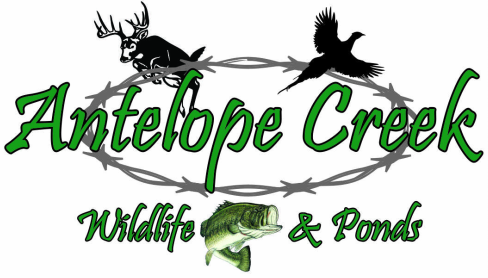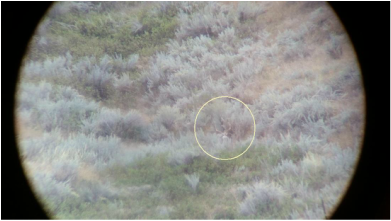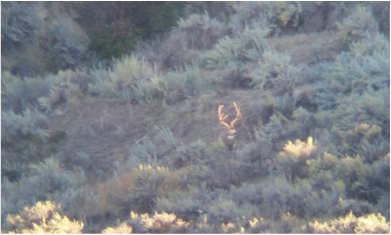The first step is to find the potential feeding and bedding areas in the area you will be hunting. Feeding areas could be agricultural fields, fruit trees or open river or creek bottoms with lush native vegetation. For bedding areas look for deer draw or washes, bowls up on the sides of big hills with scattered timber or even big sage brush. Windblown areas on the sides of hill or on the point of a ridge can also be good spots. The bedding areas will change from early to late season and with differing weather patterns. For example on really hot early season days you will find deer deep in draws and in tree thickets versus maybe on a sunny hillside during a cold snap or after a fresh snow or after a rain they may be in the open to dry off. Either way though mature bucks generally will not fully expose themselves. Much of this research can be done by using Google Earth before you ever go hunt an area.
Once I have these two areas picked out in an area I want to hunt I look for a high point to glass off to the side. Often the deer will use the big drainages to go to and from bedding to feeding areas, often feeding on native vegetation both on the way to a feeding area and from back to bed. I want to find a high spot where I can see both feeding area and at least the start of the bedding areas and am able to see the entire drainage. This is where I will take my Nikon spotting scope and binoculars to sit and observe deer and see what kind of bucks are in the area and how the deer travel. You may even be able to pin point areas they are exactly bedding in, but at least I will hopefully find whether there is a mature buck there that I would like to hunt. Once I find that buck I want to pursue I begin to focus on the bedding areas.
Start glassing back just off the edge of the bedding areas and start looking for bucks. Often times you need to sit at least an hour maybe even two if you have the time before moving again. First use your binoculars to look for obvious targets if you cannot find them go to your spotting scope. I start by looking in all the shadows first. This is generally where you will find a buck especially in the early season. Looks in cut banks, rock out cropping around trees and big sage brush. Often times you will not find the entire deer exposed look for an ear twitch, an antler sticking above vegetation or obstacles or even a rump that is exposed. This is where a good spotting scope is critical; you need to be able to find the small details that may lead you to that buck of a lifetime.
Once you have sat one area looking for bedded deer get up and move to another high point to try and get another angle on things. I always try to move with the wind in my face while moving glassing points. If you do not see anything right off the bat do not worry and think there is nothing keep looking. Patience is key here. I would recommend sitting at least half an hour if not closer to an hour. It can take some time to find a buck down in there but if he is there you can find him. Also keep in mind that as the sun moves the deer too will get up a reposition himself back into the shade. It may not be for more than an little time to stretch browse a little and lay back down but it can be just enough for you to pin point his location.
Finally remember the wind. Often times a buck will bed in an area depending of wind direction. If you can a slight breeze you may find him bedded with the wind in his face and his back up again an embankment so nothing can come from directly behind him. Stronger winds they will likely bed out of the wind. However every buck is different and this may not be true of all them. However I feel shadows and sunlight seems to be a pretty good bet on where you can find them.
Good luck out there and remember,
Hunt Safe, Hunt Hard but Hunt Smart
Brett Kleinschmit



 RSS Feed
RSS Feed
